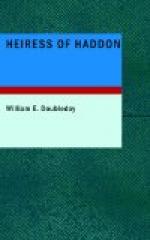CHAPTER I.
At first sight.
There is a spirit brooding o’er
these walls
That tells the record of a bygone day,
When ’mid the splendour of these
courtly halls,
A pageant shone, whose gorgeous array
Like pleasure’s dream has passed
away.
Anon.
Where both deliberate the love is slight;
Who ever loved that love not at first
sight?
Marlowe.
Amid the hills of Derbyshire which cluster around the Peak there rises, in a lovely dale slyly peeping out from behind the surrounding trees, the fine old pile of Haddon Hall.
Perhaps the old shire of Derby, with its many rich examples, can present to view nothing equal in historic and legendary interest to this old mansion. Its turrets and towers, its windows and its walls, its capacious kitchens, and its fine halls and banqueting rooms—unspoiled by the hands of the “restorer”—have gained for it the almost unchallenged position of being the finest baronial residence which still exists.
There stand the grey old walls whose battlements have proudly bidden defiance to the storms and blasts of half a thousand winters, and there still stand the gnarled old trees which have gently swayed to and fro while many a baron has ruled the Hall, and whose leaves after growing in superlative beauty, seeming to partake in the grandeur and pride of the “King of the Peak,” have drooped and fallen, after having made, with their rich autumnal tints, a succession of beautiful living pictures which have delighted the lords and ladies of Haddon for almost twenty generations.
When William the Conqueror had invaded England and had succeeded in seating himself upon his somewhat insecure throne, he began to reward his followers with liberal grants of the land he had won. Among these fortunate individuals was one, William Peveril, said to be a son of the Conqueror, and to him, in common with many other estates in and around Derbyshire, was given the manor of Haddon. Part of the fabric which was then erected is still standing, and it is surmised by some that traces are still left of a previous Saxon erection. In the year 1154, the estate was forfeited to the Crown, and it was granted by King Henry II. to the Avenals, from which family, two hundred years later, it was transferred by marriage to the Vernons.
Its fate has been strangely wrapped up in the history of its women, for as it passed from the Avenals to the Vernons by marriage, so again, three centuries later, by a similar process, it passed from the Vernon family to the Rutland, which ever since has retained it in its possession.
Everything around, both inside and out, is fragrant with interest. Everything seems to breathe out the spirit of departed ages. It is one vast relic of “Merrie England’s” bygone splendour.




